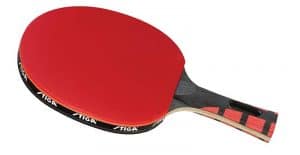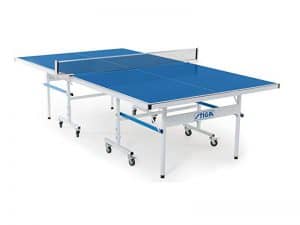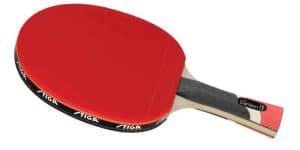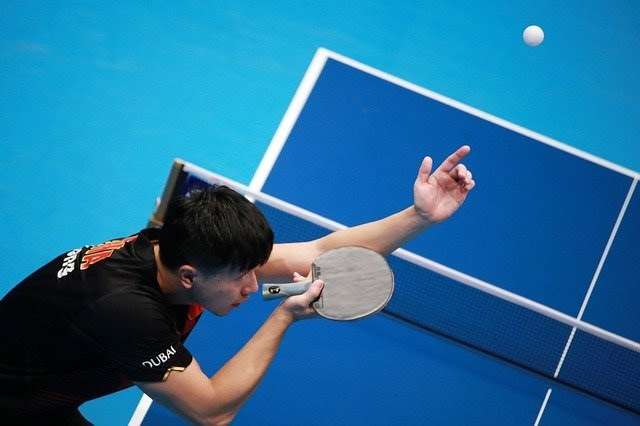Donic Baracuda Review
- Eugene Sandoval
- Last updated
The Donic Barracuda rubber is made in the European style with a soft sponge and a less than tacky topsheet. It allows for players to produce high amounts of spin and speed while being more forgiving than Chinese style rubbers.
Specifications
- Rating: Speed: 9.1, Spin: 9.8, Control: 7.1
- Smooth inverted Table Tennis rubber sheet
- Table Tennis rubber sheets cover one side of a blade
Forehand
On the forehand side, the Barracuda is capable of producing a lot of topspin. The softer rubber allows for a lot of dwell time, which allows for a great deal of spin to be produced when the ball when is struck correctly. Because the rubber is softer, it is also less susceptible to backspin, making flipping backspin and looping against backspin straightforward and simple with good technique.
Close to the table the rubber is quick and responsive, and it functions well with shorter strokes. The rubber also has high throw angle, which makes strokes farther away from the table clear the net with a high degree of consistency. While it has a lot of consistency and a high degree of ease of use, some players might be put off by the lack of speed the rubber produces, especially on the forehand side.
Backhand
In my opinion, the Barracuda performs well on the backhand side, and that was the side that I used it on primarily. While it does not have the highest speed rating, the Barracuda is still capable of producing a great deal of force from flatter strokes, which made it perfectly suited to the backhand side, where smacking the ball and hitting flatter are most players natural tendencies.
The wide range of spin that can be produced coupled with the forgiving nature of the soft rubber tospheet make this a perfect rubber for huge, physical loops as well as finessed pushes and chops, without fear of the spin opponents apply to the ball.
Serves and Power
The Barracuda rubber will improve many players’ serves instantly; it has a wide range of speed and spin that make serves hard to figure out in match situations. On backspin serves, opponents will struggle to get the ball above the net with the high amount of spin that is produced. On deep, fast serves, the speed of the rubber will give your opponent almost no time to react.
The only issue that may arise from players using this rubber is the high amount of spin produced, it may force more errors from the server, because if a high-spin serve is returned, it will most likely arrive with even more spin than was initially imparted during the serve. Consequently, players without tactical insights into the game should avoid this rubber, because often times they will be beaten by their own spin on the third ball, rather than being beaten by their opponent’s own spin or play.
Great Control, Good for Pushes and Chops
In touch play on short pushes, the Barracuda performs exceedingly well. It produces a high amount of backspin that forces a considerable number of errors from the opponent. The rubber is also highly responsive due to the soft sponge, and will give the user instant, intuitive feedback as to why a push, chop, loop, or serve failed to land on the table.
Because of the soft sponge, the Barracuda is also suited to attacking backspin balls, as it is less susceptible to back and sidespin than harder and higher tension rubbers. This is the perfect rubber for backhand and forehand flicks because of the high amount of speed and topspin that can be produced with great consistency.
Defensive Oriented
Perhaps the strongest stroke that the Barracuda has in its locker is its blocking. Blocking with this rubber is almost effortless; it has enough innate power to send the ball back over the net with ease, and because it’s less susceptible to spin, even receiving balls with huge amounts of topspin is not an issue when blocking with this rubber. This rubber can turn what is effectively a defensive play, blocking, into offensive counterattacks with almost no extra force being applied by the user (think J. O. Waldner). The subtle disguise that the Barracuda allows for can add a huge new layer of depth to anyone’s game, and will leave aggressive opponents second guessing their shots, for fear that the power they are hitting with will be used against them.
Conclusion
I consider Barracuda rubbers to be the proverbial “old faithful” of the table tennis rubber market. The Barracuda is considerably cheaper than rubbers from Butterfly’s Tenergy series, or Stiga’s Calibra and Airoc series. There is almost no gap in quality between the Barracuda, and its more expensive counterparts. Used by professionals and intermediate players alike, the Barracuda can be an explosive addition to almost any player’s game. This is the perfect rubber for an intermediate level player buying a custom made blade and rubbers for the first time. It is also perfect for more advanced players who prefer European style rubbers that produce a lot of spin on serves, topspin loops, chops, and pushes.
All in all, I think all table tennis players should see what the Barracuda rubber could do for their game. Its consistency, power, and a huge degree of variety in speed and spin can help anyone to improve different parts of their game.
Eugene (Gene) Sandoval has been one of those guys who spent too many hours around ping pong tables in high school. However, soon enough, Gene understood that there is more to ping pong than having fun. That is how he started a journey that made Eugene one of the experienced semi-professional ping pong players in the United States. As the founder of the PingPongRuler, Eugene spends most of his time surrounded by ping pong tables and research. He always has this knack for coming up with new ping pong strategies and telling the good and bad equipment apart.
-
Eugene Sandovalhttps://pingpongruler.com/author/admin/
-
Eugene Sandovalhttps://pingpongruler.com/author/admin/
-
Eugene Sandovalhttps://pingpongruler.com/author/admin/
-
Eugene Sandovalhttps://pingpongruler.com/author/admin/
Popular Products
Join our email list for exclusive reviews & the latest Ping Pong News
Sign up to our newsletter and stay up-to-date with the latest news in the ping pong world, and be the first to read our new product reviews. We promise, no spam


















